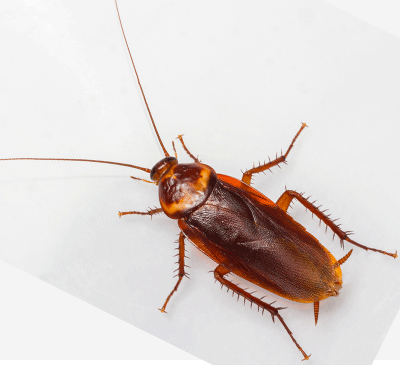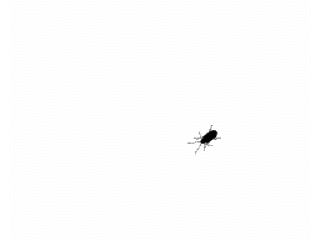
From $175
consider one of our package deals which can save you money
COCKROACH PEST CONTROL SERVICES PERTH
There are several different species of cockroaches found in the Perth Metropolitan region. Some pest cockroach species are commonly found in commercial food handling premises and in kitchens, particularly within institutional buildings such as hospitals.
Omnivorous with mouthparts adapted for biting they will feed on almost anything from paper to soap but need free water. Being nocturnal, they hide during daylight in crack and crevices around sinks, drains and sewers. They live together in harbourages, have few natural predators and exude a distinctive unpleasant odour.
German Cockroach
Appearance
- 12–15mm long
- Brown with 2 dark stripes on thorax
- The wings are as long as the body or slightly overlapping in both sexes
- Runs and climbs (sticky pads on the feet)
Lifecycle
- Females carry 35 – 40 eggs in an ootheca (egg case) until they are ready to hatch
- Hatch in 1 month
- Nymphs take between 6 weeks to 6 months to develop into adults
Habits of a German Cockroach
- Frequents heated buildings, often kitchens and ships. Prefers high temperatures and humidities
- Nocturnal
- Omnivorous
Problem Pest: German cockroaches are the common and unsightly pest associated with kitchens. They are more likely to cause food poisoning that most other species due to the fact they come in contact with food or food preparation surfaces directly. They are also prolific breeders with females producing over 300 offspring in their life time (up to six months).
Oriental Cockroach
Appearance
- Dark brown or black in colour
- 20-25mm long
- The wings undeveloped in female and cover ¾ length of the abdomen in the male
Lifecycle
- Females deposit 16 eggs in an ootheca (egg case)
- Hatch in 2 months
- Nymphs take 6-18 months to develop into adults
Habits of an Oriental Cockroach
- Omnivorous with mouthpart adapted for biting they will feed on almost anything from paper to soap but need free water
- Nocturnal, they hide during daylight in crack and crevices around sinks, drains and sewers
- They live together in harbourages, have few natural predators and exude a distinctive unpleasant odour
American Cockroach
Appearance
- 35-40mm long
- Shining red–brown in color
- Wings longer than the body in male; only just overlap abdomen in female
- Runs (may fly at very high temperatures)
Lifecycle
- The ootheca (egg case) containing up to 16 eggs is carried by the female for several days before being deposited. Sometimes cemented down and tend to be grouped
- Hatch in 1–2 months
- Nymphs usually develop in 6-12 months, but it can take up to 15 months
Habits of the American Cockroach
- the American cockroach prefers dark, humid and undisturbed areas and can be found in subfloors, basements, kitchens, roof voids and bathrooms of homes
Australian Cockroach
Appearance
- Australian cockroach are an average length of around 4cm (1.6 in) and about7 mm (0.28 in) tall.[8] They are reddish brown and have a yellowish margin on the body region behind the head. Immature cockroaches resemble adults except they are wingless
- The cockroach is divided in three sections; the body is flattened and broadly oval, with a shield-like pronotum covering its head. A pronotum is a plate-like structure that covers all or part of the dorsal surface of the thorax of certain insects.
- They also have chewing mouth parts, long, segmented antennae, and leathery fore wings with delicate hind wings. The third section of the cockroach is the abdomen.[
Lifecycle
- Females deposit the ootheca (egg case) containing 24 eggs a day after production.
- After hatching nymphs take 6-12 months to develop into adults.
Habits of the Australian Cockroach
- Enter buildings at night from gardens/debris
- Generally prevalent in areas where winters are relatively mild
- Despite its name, it isn’t a native species
Brown-Banded Cockroach
Appearance
- This is a small species of cockroach measuring about 10–14mm long
- It is tan to light brown and has two light-colored bands across the wings and abdomen which may sometimes appear to be broken or irregular but are quite noticeable
- The bands may be partly obscured by the wings
Lifecycle
- Females deposit the ootheca (egg case) containing 24 eggs a day after production
- After hatching nymphs take 6-12 months to develop into adults
Habits of the Brown-Banded Cockroach
- Brown-banded cockroaches mostly stay on ground, but may fly in very warm climates
- Their preference for warm, humid environments leads them to harbourages within heated buildings - ceilings, attics, inside and around appliance motors
- Primarily active at night, these opportunistic feeders particularly enjoy materials with high starch contents
HOW PESTS OUT WA CAN HELP
Successful control of cockroaches requires planning followed by an extensive and thorough treatment by a professional pest control company.To eradicate this persistent pest requires a close understanding of its biology, lifestyle and habits.
Pests Out WA has that expertise and years of practical field experience. We know exactly which products to use, when to use them and where.
Methods of Treatment Include:
Residual Insecticidal Spray
Insecticidal Dusting
Gel baiting
Insecticidal Aerosol
Smoke Generator
Our number one priority is the health and safety of your family and pets. The main products we use are modelled on natures very own insecticide ‘pyrethrum’ derived from the chrysanthemum flower and are completely colourless, odourless, simple and effective.



